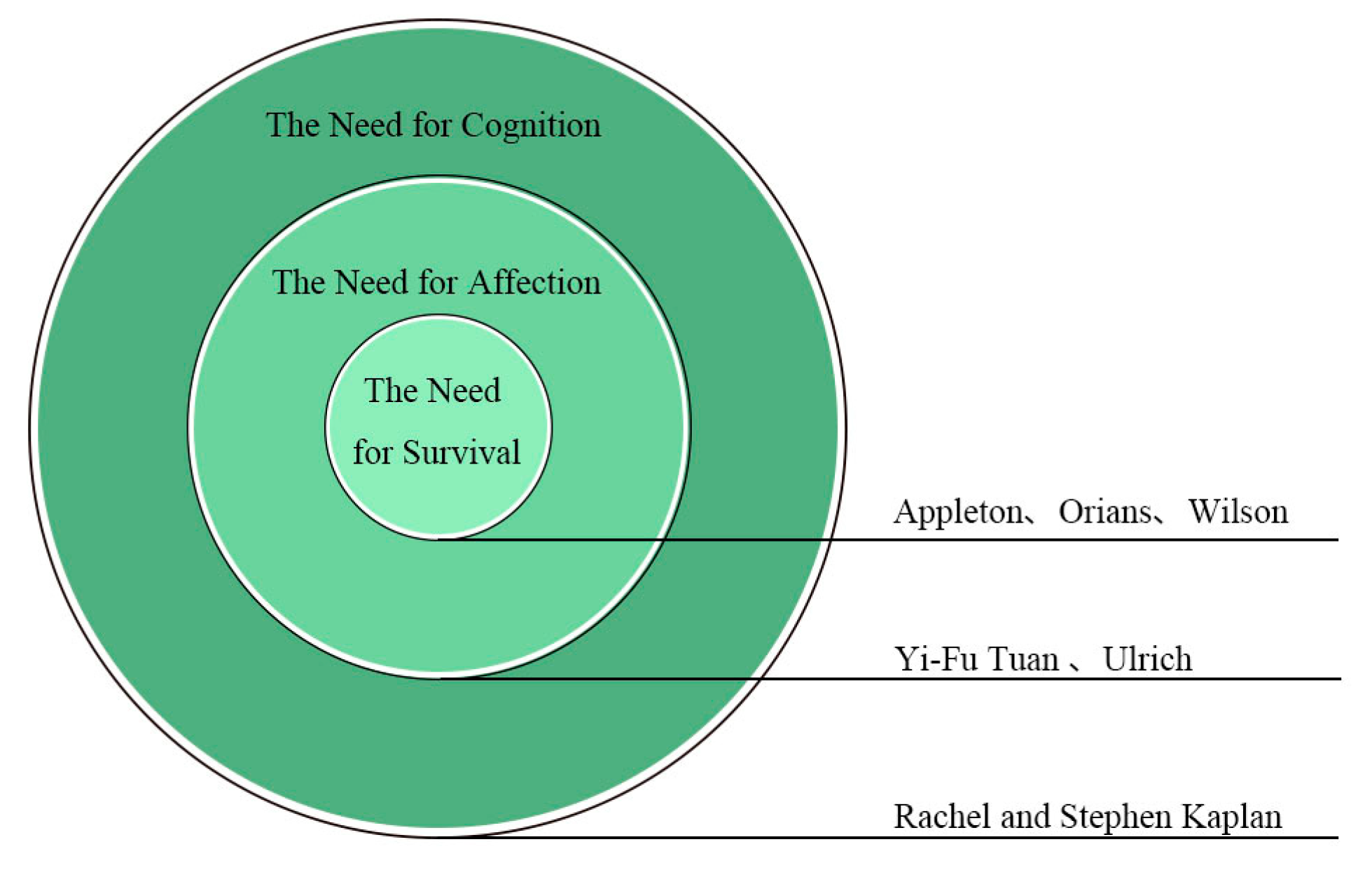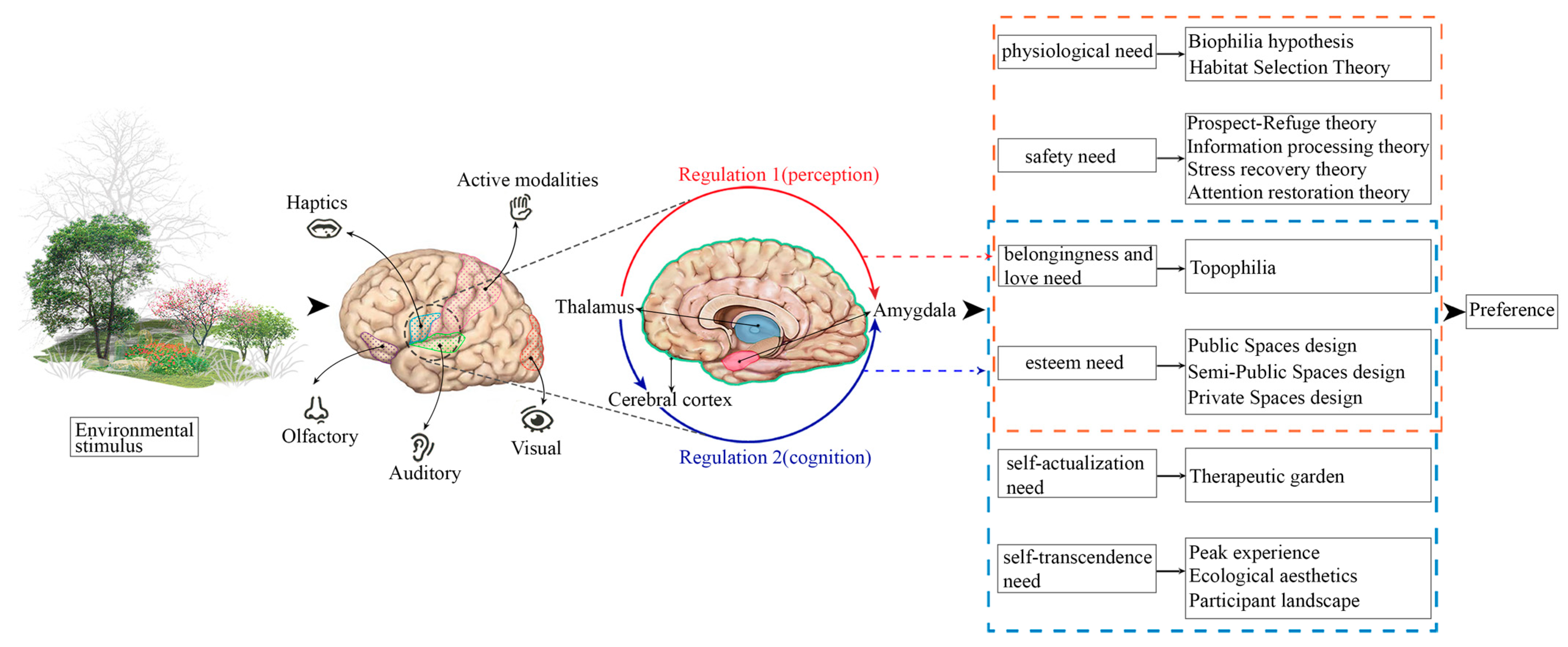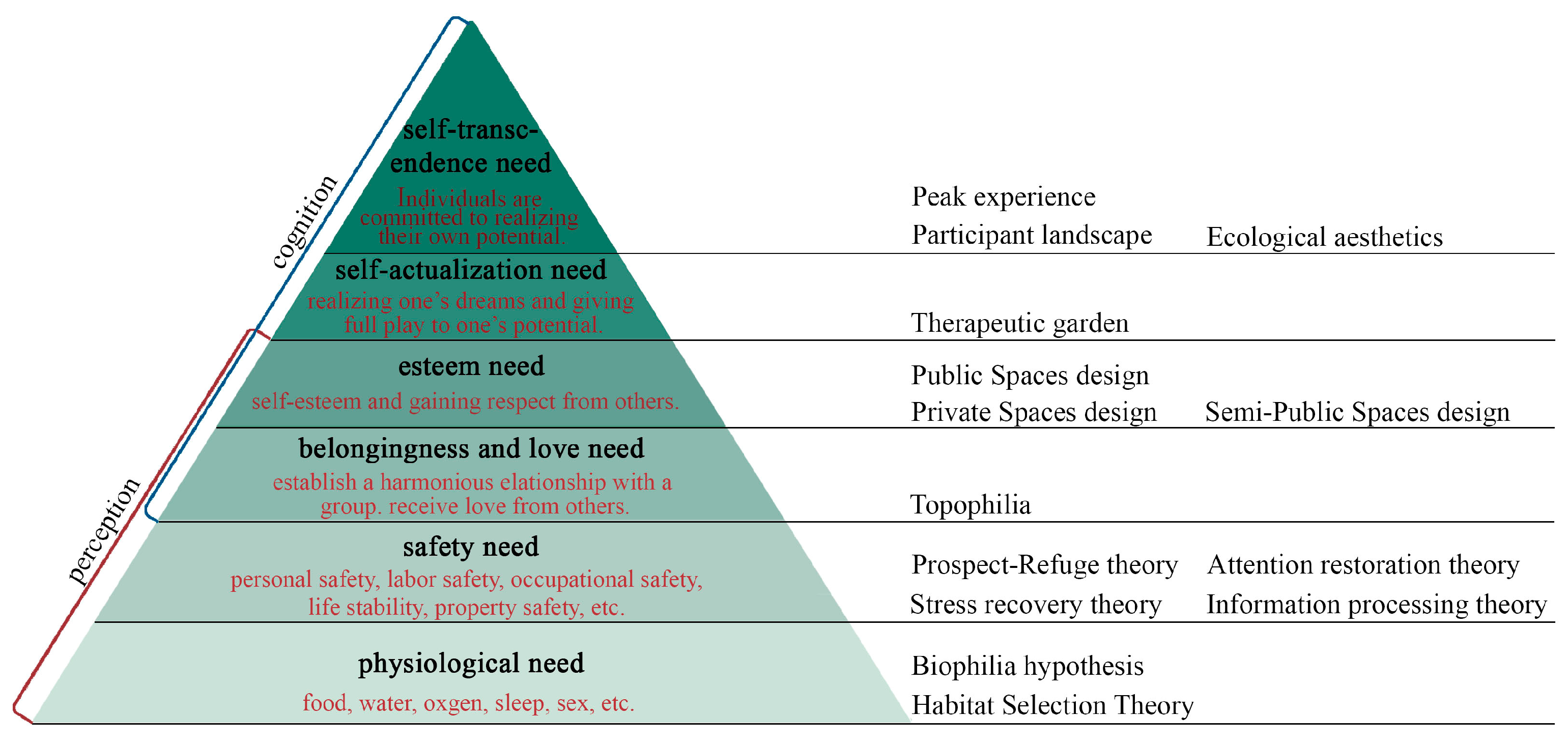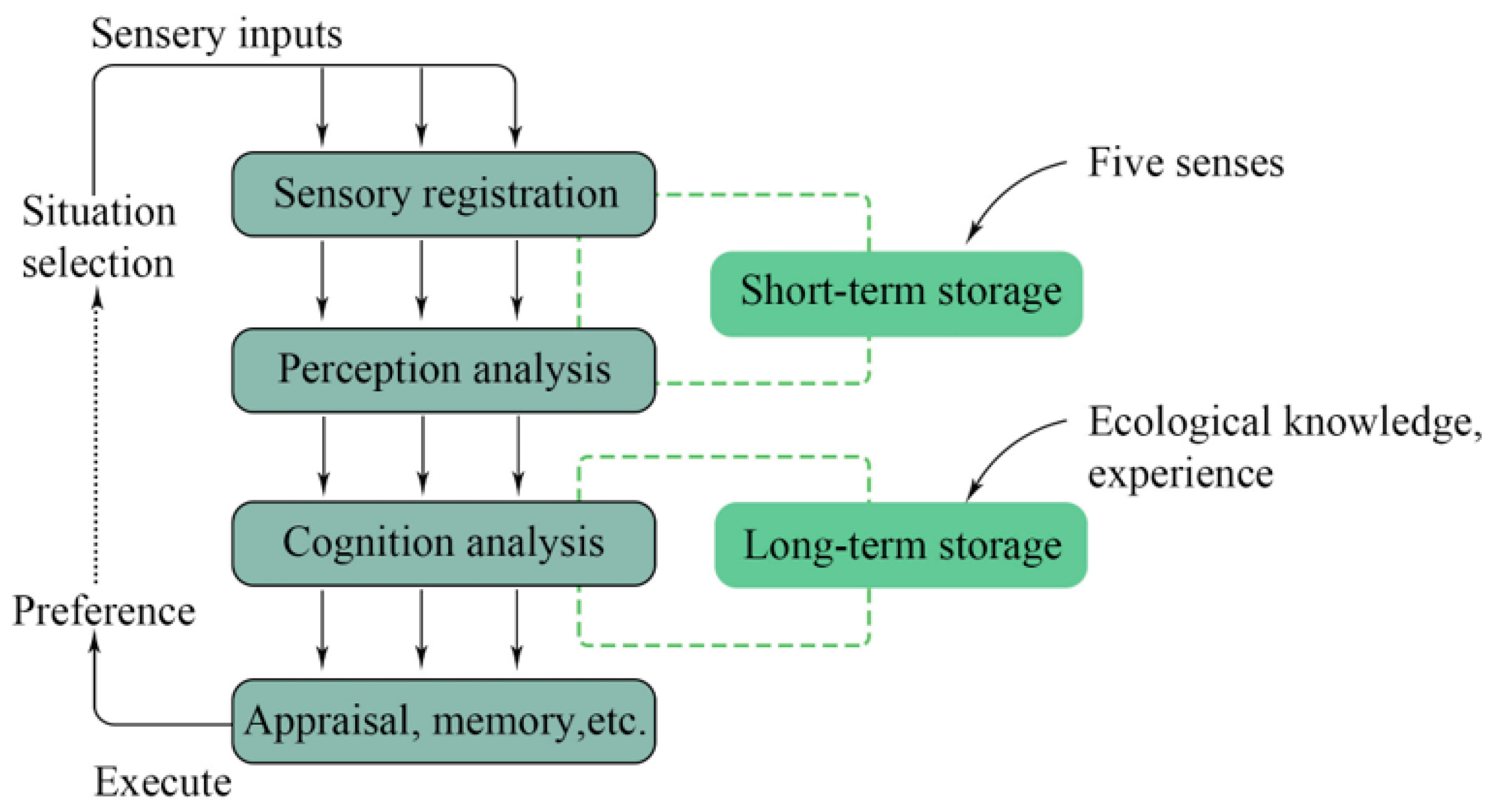Towards a “Positive Landscape”: An Integrated Theoretical Model of Landscape Preference Based on Cognitive Neuroscience
Abstract
:1. Introduction
2. Materials and Methods
3. Development of Landscape Preference Theories
3.1. The Need for Survival
3.2. The Need for Affection
3.3. The Need for Cognition
4. A Theoretical Model of Landscape Preference Based on Cognitive Neuroscience
4.1. The Neural Basis of Landscape Preference Evaluation
4.2. The Nerve Conduction Path of Environmental Information
4.3. Evaluation Based on Maslow’s Hierarchy of Needs
4.3.1. Physiological Needs
4.3.2. Safety Needs
4.3.3. Love and Belonging Needs
4.3.4. Esteem Needs
4.3.5. Self-Actualization Needs
4.3.6. Self-Transcendence Needs
5. Towards a “Positive Landscape”: Application of the Landscape Preference Model
5.1. The Definition of a “Positive Landscape”
5.2. Understanding Human Landscape Preferences Using the Integrated Landscape Preference Model
5.3. Using the Integrated Model to Regulate Human Landscape Preferences: Ecological Landscape as an Example
6. Conclusions
Author Contributions
Funding
Institutional Review Board Statement
Informed Consent Statement
Data Availability Statement
Conflicts of Interest
References
- Council of Europe (CE). European Landscape Convention, ETS No.176; Council of Europe: Trasbourg, France, 2000. [Google Scholar]
- Kaplan, R.; Kaplan, S. The Experience of Nature: A Psychological Perspective; Cambridge University Press: New York, NY, USA, 1989. [Google Scholar]
- Kearney, A.R.; Bradley, G.A.; Petrich, C.H.; Kaplan, R.; Kaplan, S.; Simpson-Colebank, D. Public perception as support for scenic quality regulation in a nationally treasured landscape. Landsc. Urban Plann. 2008, 87, 117–128. [Google Scholar] [CrossRef]
- Swanwick, C. Society’s attitudes to and preferences for land and landscape. Land Use Policy 2009, 26, S62–S75. [Google Scholar] [CrossRef]
- Zube, E.H.; Sell, J.L.; Taylor, J.G. Landscape perception: Research, application and theory. Landsc. plann. 1982, 9, 1–33. [Google Scholar] [CrossRef]
- Ittelson, W.H.; Cantril, H. Perception; A Transactional Approach; Norton: New York, NY, USA, 1954. [Google Scholar]
- Zube, E.H.; Brush, R.O.; Fabos, J.G. Landscape Assessment: Values, Perceptions and Resources; Dowden, Hutchinson and Ross Co. Inc.: Stroudsburg, PA, USA, 1975. [Google Scholar]
- Dewey, J.; Bentley, A.F. Knowing and the Known; Beacon Press Boston: Boston, MA, USA, 1949; Volume 111. [Google Scholar]
- Yuan, S.; Browning, M.H.; McAnirlin, O.; Sindelar, K.; Shin, S.; Drong, G.; Hoptman, D.; Heller, W. A virtual reality investigation of factors influencing landscape preferences: Natural elements, emotions, and media creation. Landsc. Urban Plann. 2023, 230, 104616. [Google Scholar] [CrossRef]
- Gobster, P.H. Forest aesthetics, biodiversity, and the perceived appropriateness of ecosystem management practices. In General Technical Report PNW-369, Proceedings of the Defining Social Acceptability in Ecosystem Management A Workshop Proceedings, Kelso, WA, USA, 23—25 June 1992; Brunson, M.W., Kruger, L.E., Tyler, C.B., Schroeder, S.A., Eds.; U.S. Department of Agriculture, Forest Service, Pacific Northwest Research Station: Portland, OR, USA, 1996; pp. 77–98. [Google Scholar]
- Tieskens, K.F.; Van Zanten, B.T.; Schulp, C.J.; Verburg, P.H. Aesthetic appreciation of the cultural landscape through social media: An analysis of revealed preference in the Dutch river landscape. Landsc. Urban Plann. 2018, 177, 128–137. [Google Scholar] [CrossRef]
- Jorgensen, A. Beyond the view: Future directions in landscape aesthetics research. Landsc. Urban Plann. 2011, 100, 353–355. [Google Scholar] [CrossRef]
- McGuire, J.R. Managing the forest landscape for public expectations. In General Technical Report PSW; Pacific Southwest Forest and Range Experiment Station, Forest Service, U.S. Department of Agriculture: Washington, DC, USA, 1978; pp. 16–18. [Google Scholar]
- Gobster, P.H. An ecological aesthetic for forest landscape management. Landsc. J. 1999, 18, 54–64. [Google Scholar] [CrossRef]
- Crandell, G.; Treib, M. Nature Pictorialized: The View in Landscape History. J. Gard. Hist. 1995, 15, 55–57. [Google Scholar]
- Clark, K.; Taylor, F. Landscape into Art; John Murray Publishers Ltd.: London, UK, 1949. [Google Scholar]
- Rees, R. The scenery cult: Changing landscape tastes over three centuries. Landscape 1975, 19, 39–47. [Google Scholar]
- Fudge, R.S. Imagination and the science-based aesthetic appreciation of unscenic nature. J. Aesthet. Art Crit. 2001, 59, 275–285. [Google Scholar] [CrossRef]
- Gobster, P.H. Development of ecological aesthetics in the West: A landscape perception and assessment perspective. Acad. Res. 2010, 4, 2–12. [Google Scholar]
- Rolston, H. From beauty to duty: Aesthetics of nature and environmental ethics. In Environment and the Arts: Perspectives on Environmental Aesthetics; Berleant, A., Ed.; Ashgate Publishing Limited: Aldershot, UK, 2002; pp. 127–141. [Google Scholar]
- Leopold, A. A Sand County Almanac; Oxford University Press: Oxford, UK, 1949. [Google Scholar]
- Huang, Z.; Zhang, W. Neuroaesthetics: Exploring aesthetics and the brain. Adv. Psychol. Sci. 2012, 20, 672–681. [Google Scholar] [CrossRef]
- Isen, A.M.; Daubman, K.A.; Nowicki, G.P. Positive affect facilitates creative problem solving. J. Pers. Soc. Psychol. 1987, 52, 1122. [Google Scholar] [CrossRef] [PubMed]
- Kahn, B.E.; Isen, A.M. The influence of positive affect on variety seeking among safe, enjoyable products. J. Consum. Res 1993, 20, 257–270. [Google Scholar] [CrossRef]
- Arthur, L.M. Predicting scenic beauty of forest environments: Some empirical tests. For. Sci. 1977, 23, 151–160. [Google Scholar]
- Ulrich, R.S. Visual landscape preference: A model and application. Man-Environ. Syst. 1977, 7, 279–293. [Google Scholar] [CrossRef]
- Daniel, T.C.; Vining, J. Methodological issues in the assessment of landscape quality. In Behavior and the Natural Environment; Altman, I., Wohlwill, J., Eds.; Plenum Press: New York: NY, USA, 1983; pp. 39–84. [Google Scholar]
- Kaplan, S. A model of person-environment compatibility. Environ. Behav. 1983, 15, 311–332. [Google Scholar] [CrossRef]
- Maslow, A.H. Preface to motivation theory. Psychosom. Med. 1943, 5, 85–92. [Google Scholar] [CrossRef]
- Atkinson, R.L.; Atkinson, R.C.; Smith, E.E.; Bem, D.J.; Nolen-Hoeksema, S. Hilgard’s Introduction to Psychology; Harcourt Brace College: Fort Worth, TX, USA, 1996. [Google Scholar]
- Larsen, R.J.; Buss, D.M. Personality Psychology: Domains of Knowledge about Human Nature; McGraw-Hill: Boston, MA, USA, 2002. [Google Scholar]
- Zavei, S.J.A.P.; Jusan, M.M. Exploring housing attributes selection based on Maslow’s hierarchy of needs. Procedia-Soc. Behav. Sci. 2012, 42, 311–319. [Google Scholar] [CrossRef] [Green Version]
- Montag, C.; Sindermann, C.; Lester, D.; Davis, K.L. Linking individual differences in satisfaction with each of Maslow’s needs to the Big Five personality traits and Panksepp’s primary emotional systems. Heliyon 2020, 6, e04325. [Google Scholar] [CrossRef]
- Nukarinen, T.; Rantala, J.; Korpela, K.; Browning, M.H.; Istance, H.O.; Surakka, V.; Raisamo, R. Measures and modalities in restorative virtual natural environments: An integrative narrative review. Comput. Human. Behav. 2022, 126, 107008. [Google Scholar] [CrossRef]
- Maslow, A.H. The farther reaches of human nature. J. Transpers. Psychol. 1969, 512, 441-8988. [Google Scholar]
- Maslow, A.H. The Farther Reaches of Human Nature; Viking Press: New York, NY, USA, 1971; Volume 19711. [Google Scholar]
- Maslow, A.H. The Journals of A. H. Maslow; Lowry, R.J., Freedman, J., Eds.; Lewis Publishing Company: Washington, DC, USA, 1982; Volume 1. [Google Scholar]
- Sutich, A. The emergence of the transpersonal orientation: A personal account. J. Transpers. Psychol. 1976, 8, 5–19. [Google Scholar]
- Koltko-Rivera, M.E. Rediscovering the later version of Maslow’s hierarchy of needs: Self-transcendence and opportunities for theory, research, and unification. Rev. Gen. Psychol. 2006, 10, 302–317. [Google Scholar] [CrossRef]
- Greene, L.; Burke, G. Beyond self-actualization. J. Health Hum. Serv. Adm. 2007, 30, 116–128. [Google Scholar]
- Cronin, M.A.; George, E. The why and how of the integrative review. Organ. Res. Methods. 2023, 26, 168–192. [Google Scholar] [CrossRef]
- Souza, M.T.D.; Silva, M.D.D.; Carvalho, R.D. Integrative review: What is it? How to do it? Einstein (São Paulo) 2010, 8, 102–106. [Google Scholar] [CrossRef] [PubMed]
- Kudret, S.; Erdogan, B.; Bauer, T.N. Self-monitoring personality trait at work: An integrative narrative review and future research directions. J. Organ. Behav. 2019, 40, 193–208. [Google Scholar] [CrossRef]
- Zhao, X.; Zuo, J.; Wu, G.; Huang, C. A bibliometric review of green building research 2000–2016. Archit. Sci. Rev. 2019, 62, 74–88. [Google Scholar] [CrossRef]
- Badampudi, D.; Wohlin, C.; Petersen, K. Experiences from using snowballing and database searches in systematic literature studies. In Proceedings of the 19th International Conference on Evaluation and Assessment in Software Engineering, Nanjing, China, 27–29 April 2015; pp. 1–10. [Google Scholar]
- Wohlin, C. Guidelines for snowballing in systematic literature studies and a replication in software engineering. In Proceedings of the 18th International Conference on Evaluation and Assessment in Software Engineering, London, UK, 13–14 May 2014; pp. 1–10. [Google Scholar]
- Kaplan, R. The analysis of perception via preference: A strategy for studying how the environment is experienced. Landsc. Plann. 1985, 12, 161–176. [Google Scholar] [CrossRef] [Green Version]
- Kaplan, S. The role of location processing in the perception of the environment. In Proceedings of the Second Annual Environmental Design Research Association Conference, Tempe, AZ, USA, 4–7 April 2020; Carnegie-Mellon University: Pittsburgh, PA, USA, 1970; pp. 131–134. [Google Scholar]
- Kaplan, R. Preference and everyday nature: Method and application. In Perspectives on Environment and Behavior: Theory, Research, and Applications; Plenum: New York, NY, USA, 1977; pp. 235–250. [Google Scholar]
- Ulrich, R.S. Human responses to vegetation and landscapes. Landsc. Urban Plann. 1986, 13, 29–44. [Google Scholar] [CrossRef]
- Appleton, J. The Experience of Landscape; John Wiley & Sons Press: New York, NY, USA, 1975. [Google Scholar]
- Orians, G.H. Habitat selection: General theory and applications to human behavior. In Evolution of Human Social Behavior; Lockard, J., Ed.; Elsevier: New York, NY, USA, 1980; pp. 49–77. [Google Scholar]
- Moura, J.; Ferreira Júnior, W.S.; Silva, T.C.; Albuquerque, U.P. The influence of the evolutionary past on the mind: An analysis of the preference for landscapes in the human species. Front. Psychol. 2018, 9, 2485. [Google Scholar] [CrossRef] [PubMed]
- Chen, X.; Wang, B.; Zhang, B. Far from the “madding crowd”: The positive effects of nature, theories and applications. Adv. Psychol. Sci. 2016, 24, 270–281. [Google Scholar] [CrossRef]
- Wilson, E.O. Biophilia; Harvard University Press: Cambridge, MA, USA, 1984. [Google Scholar]
- Cai, K.; Huang, W.; Lin, G. Bridging landscape preference and landscape design: A study on the preference and optimal combination of landscape elements based on conjoint analysis. Urban For. Urban Green. 2022, 73, 127615. [Google Scholar] [CrossRef]
- Dai, C.; Maruthaveeran, S.; Shahidan, M.F.; Chu, Y. Landscape Preference Evaluation of Old Residential Neighbourhoods: A Case Study in Shi Jiazhuang, Hebei Province, China. Forests 2023, 14, 375. [Google Scholar] [CrossRef]
- Schacter, D.L.; Gilbert, D.T.; Wegner, D.M. Psychology; Worth: New York, NY, USA, 2009. [Google Scholar]
- Ulrich, R.S. Aesthetic and affective response to natural environment. In Behavior and the Natural Environment; Altman, I., Wohlwill, J.F., Eds.; Plenum: New York, NY, USA, 1983; pp. 85–125. [Google Scholar]
- Tuan, Y.F. Topophilia: A Study of Environmental Perception Attitudes, and Values; Colombia Press University: Bergen, NJ, USA, 1974. [Google Scholar]
- Chang, J.; Lin, Z.; Vojnovic, I.; Qi, J.; Wu, R.; Xie, D. Social environments still matter: The role of physical and social environments in place attachment in a transitional city, Guangzhou, China. Landsc. Urban Plann. 2023, 232, 104680. [Google Scholar] [CrossRef]
- Ulrich, R.S.; Simons, R.F.; Losito, B.D.; Fiorito, E.; Miles, M.A.; Zelson, M. Stress recovery during exposure to natural and urban environments. J. Environ. Psychol. 1991, 11, 201–230. [Google Scholar] [CrossRef]
- Kaplan, S. The restorative benefits of nature: Toward an integrative framework. J. Environ. Psychol. 1995, 15, 169–182. [Google Scholar] [CrossRef]
- Li, H.; Zhang, G. How can plant-enriched natural environments benefit human health: A narrative review of relevant theories. Int. J. Environ. Health Res. 2023, 1–14. [Google Scholar] [CrossRef]
- Kaplan, R.; Kaplan, S.; Brown, T. Environmental preference: A comparison of four domains of predictors. Environ. Behav. 1989, 21, 509–530. [Google Scholar] [CrossRef] [Green Version]
- Kaplan, S. Aesthetics, affect, and cognition: Environmental preference from an evolutionary perspective. Environ. Behav. 1987, 19, 3–32. [Google Scholar] [CrossRef] [Green Version]
- Wartmann, F.M.; Frick, J.; Kienast, F.; Hunziker, M. Factors influencing visual landscape quality perceived by the public. Results from a national survey. Landsc. Urban Plann. 2021, 208, 104024. [Google Scholar] [CrossRef]
- Van den Berg, A.E.; Koole, S.L.; van der Wulp, N.Y. Environmental preference and restoration:(How) are they related? J. Environ. Psychol. 2003, 23, 135–146. [Google Scholar] [CrossRef]
- Zuckerman, M. Development of a situation-specific trait-state test for the prediction and measurement of affective responses. J. Consult. Clin. Psychol. 1977, 45, 513. [Google Scholar] [CrossRef] [PubMed]
- Ulrich, R.S. Visual landscapes and psychological well-being. Landsc. Res. 1979, 4, 17–23. [Google Scholar] [CrossRef]
- Berlyne, D.E.; Lewis, J.L. Effects of heightened arousal on human exploratory behaviour. Can. J. Psychol. 1963, 17, 398–410. [Google Scholar] [CrossRef]
- O’Leary, K.D. Preference for variability of stimuli as a function of experimentally induced anxiety. Psychol. Rep. 1965, 16, 1202. [Google Scholar] [CrossRef]
- Mesulam, M. Patterns in behavioral neuroanatomy: Association areas, the limbic system, and hemispheric specialization. In Principles of Behavioral Neurology; Mesulam, M., Ed.; F.A. Davis: Philadelphia, PA, USA, 1985; pp. 1–70. [Google Scholar]
- Kaplan, S.; Berman, M.G. Directed attention as a common resource for executive functioning and self-regulation. Perspect. Psychol. Sci. 2010, 5, 43–57. [Google Scholar] [CrossRef]
- Maslow, A.H. Motivation and Personality; Harper & Row: New York, NY, USA, 1954. [Google Scholar]
- Gazzaniga, M.S.; Ivry, R.B.; Mangun, G. Cognitive Neuroscience. The Biology of the Mind; W. W. Norton & Company: New York, NY, USA, 2009; pp. 71–77. [Google Scholar]
- Fuster, J.M. Cortex and Mind: Unifying Cognition; Oxford University Press: Cambridge, MA, USA, 2003. [Google Scholar]
- Geschwind, N. Disconnexion syndromes in animals and man. Brain 1965, 88, 237. [Google Scholar] [CrossRef] [Green Version]
- Aggleton, J.P. The Amygdala: Neurobiological Aspects of Emotion, Memory, and Mental Dysfunction; Wiley-Liss: Hoboken, NJ, USA, 1992. [Google Scholar]
- LeDoux, J.E. Emotion circuits in the brain. Annu. Rev. Neurosci. 2000, 23, 155–184. [Google Scholar] [CrossRef]
- Cupchik, G.C.; Vartanian, O.; Crawley, A.; Mikulis, D.J. Viewing artworks: Contributions of cognitive control and perceptual facilitation to aesthetic experience. Brain Cogn. 2009, 70, 84–91. [Google Scholar] [CrossRef]
- Wang, N.; Yuejia, L.; Qi, D. Neural correlates of aesthetics. Adv. Psychol. Sci. 2010, 18, 19–27. [Google Scholar]
- Li, K.; Zhai, Y.; Dou, L.; Liu, J. A preliminary exploration of landscape preferences based on naturalness and visual openness for college students with different moods. Front. Psychol. 2021, 12, 629650. [Google Scholar] [CrossRef]
- Nesse, R.M. What is mood for? Psycholoquy 1991, 2, 2. [Google Scholar]
- Ekman, P. Basic emotions. Handb. Cogn. Emot. 1999, 98, 16. [Google Scholar] [CrossRef]
- Gobster, P.H.; Arnberger, A.; Schneider, I.E.; Floress, K.M.; Haines, A.L.; Dockry, M.J.; Benton, C. Restoring a “scenically challenged” landscape: Landowner preferences for pine barrens treatment practices. Landsc. Urban Plann. 2021, 211, 104104. [Google Scholar] [CrossRef]
- Yang, G.; Yu, Z.; Zhang, J.; Søderkvist Kristensen, L. From preference to landscape sustainability: A bibliometric review of landscape preference research from 1968 to 2019. Ecosyst. Health. Sust. 2021, 7, 1948355. [Google Scholar] [CrossRef]
- Berleant, A. The Aesthetics of Environment; Temple University Press: Philadelphia, PA, USA, 1992. [Google Scholar]
- Pflüger, Y.; Rackham, A.; Larned, S. The aesthetic value of river flows: An assessment of flow preferences for large and small rivers. Landsc. Urban Plann. 2010, 95, 68–78. [Google Scholar] [CrossRef]
- Tribot, A.-S.; Deter, J.; Mouquet, N. Integrating the aesthetic value of landscapes and biological diversity. Proc. R. Soc. B Biol. Sci. 2018, 285, 20180971. [Google Scholar] [CrossRef]
- Atkinson, R.C.; Shiffrin, R.M. Human memory: A proposed system and its control processes. In Psychology of learning and motivation; Elsevier: Amsterdam, The Netherlands, 1968; Volume 2, pp. 89–195. [Google Scholar]
- Gobster, P.H.; Nassauer, J.I.; Daniel, T.C.; Fry, G. The shared landscape: What does aesthetics have to do with ecology? Landsc. Ecol. 2007, 22, 959–972. [Google Scholar] [CrossRef]
- Fredrickson, B.L. What good are positive emotions? Rev. Gen. Psychol. 1998, 2, 300–319. [Google Scholar] [CrossRef]
- Tress, B.; Tress, G.; Fry, G. Researchers’ experiences, positive and negative, in integrative landscape projects. Environ. Manag. 2005, 36, 792–807. [Google Scholar] [CrossRef]
- Cameron, R.W.; Brindley, P.; Mears, M.; McEwan, K.; Ferguson, F.; Sheffield, D.; Jorgensen, A.; Riley, J.; Goodrick, J.; Ballard, L. Where the wild things are! Do urban green spaces with greater avian biodiversity promote more positive emotions in humans? Urban Ecosyst. 2020, 23, 301–317. [Google Scholar] [CrossRef] [Green Version]
- Kals, E.; Schumacher, D.; Montada, L. Emotional affinity toward nature as a motivational basis to protect nature. Environ. Behav. 1999, 31, 178–202. [Google Scholar] [CrossRef]
- Guo, T.; Dong, L. Restoration of Children’s Connection with Nature-Therapeutic Garden for Nature-deficit Disorder. Chin. Landsc. Archit. 2015, 8, 62–66. [Google Scholar] [CrossRef]
- Walker, A.J.; Ryan, R.L. Place attachment and landscape preservation in rural New England: A Maine case study. Landsc. Urban Plann. 2008, 86, 141–152. [Google Scholar] [CrossRef]
- Borrie, W.T.; Roggenbuck, J.W. The dynamic, emergent, and multi-phasic nature of on-site wilderness experiences. J. Leis. Res. 2001, 33, 202–228. [Google Scholar] [CrossRef] [Green Version]
- Ryan, R.L. Exploring the effects of environmental experience on attachment to urban natural areas. Environ. Behav. 2005, 37, 3–42. [Google Scholar] [CrossRef]
- Kaltenborn, B.P. Effects of sense of place on responses to environmental impacts: A study among residents in Svalbard in the Norwegian high Arctic. Appl. Geogr. 1998, 18, 169–189. [Google Scholar] [CrossRef]
- Rolston, H., III. Does aesthetic appreciation of landscapes need to be science-based. Brit. J. Aesthet. 1995, 35, 374–386. [Google Scholar] [CrossRef] [Green Version]
- Lee, L.-H. Perspectives on landscape aesthetics for the ecological conservation of wetlands. Wetlands 2017, 37, 381–389. [Google Scholar] [CrossRef]
- Parsons, R.; Daniel, T.C. Good looking: In defense of scenic landscape aesthetics. Landsc. Urban Plann. 2002, 60, 43–56. [Google Scholar] [CrossRef]
- Cottet, M.; Piégay, H.; Bornette, G. Does human perception of wetland aesthetics and healthiness relate to ecological functioning? J. Environ. Manag. 2013, 128, 1012–1022. [Google Scholar] [CrossRef] [PubMed]
- Dobbie, M.F. Public aesthetic preferences to inform sustainable wetland management in Victoria, Australia. Landsc. Urban Plann. 2013, 120, 178–189. [Google Scholar] [CrossRef]




| Subject | Scholar | Discipline | Theory | Psychological Implications | References |
|---|---|---|---|---|---|
| The Need for Survival | Appleton | Geographer | Prospect-Refuge Theory | From the perspective of evolutionary survival needs, the theory of Prospect-Refuge attempts to explain why certain environments give a sense of security and thus satisfy a basic human psychological need. Environments that satisfy this need often provide people with the ability to observe (prospect) without being seen (refuge). | Appleton (1975), Cai et al. (2022) [51,56] |
| Orians | Biologist | Habitat Selection Theory | During human evolution, human beings have focused on their own survival and environmental experience, and it is believed that evolutionary heritage is the basis for a consistent preference for natural environmental stimuli. | Orians (1980) [52] | |
| Wilson | Biologist | Biophilia Hypothesis | Humans have evolved in concert with nature over millions of years, so LP most probably have a genetic basis. This results in an innate need and affection for nature, reflected in a tendency to pay attention to and connect with nature and other life forms. | Wilson (1984) [55] | |
| The Need for Affection | Yi-Fu Tuan | Geographer | Topophilia | Our physical surroundings play an essential role in establishing a meaningful and orderly life, which frequently provides a sense of comfort and security. It is a positive affective bond between an individual and a particular place, with the key trait being the individual’s proclivity to maintain a close relationship with that place. | Yi-Fu Tuan (1974), Chang et al. (2023) [60,61] |
| Ulrich | Architecture | Affective Response | When people see a landscape, they act to approach it or stay away from it on the basis of the affective response of liking or disliking the landscape. This mechanism is common to all people, and the response is rapid and based on limited information. | Ulrich (1977, 1983) [26,59] | |
| Stress Reduction Theory | If an individual is stressed, exposure to non-threatening natural environments will usually have a stress-reducing or restorative effect, including many positive changes in mental state, physiological system activity levels, behavior, or function. | Ulrich (1991), Dai et al. (2023) [57,62] | |||
| The Need for Cognition | Rachel and Stephen Kaplan | Psychologist | Information Processing Theory | When engaging with the natural environment, humans require access to information to understand the environment and evaluate surroundings on the basis of their potential for exploration. On this basis, the Kaplans created a preference matrix with four informative elements that influence LP: coherence, complication, legibility, and mystery. | Kaplan R and Kaplan S (1989) [2] |
| Attention Restoration Theory | Natural environments automatically attract attention, and contact with nature can facilitate/support recovery from directed attention fatigue. Landscape environments that enable directed attention recovery tend to have four main properties: being away, fascination, extent, and compatibility. | Kaplan (1995), Li and Zhang (2022) [63,64] |
Disclaimer/Publisher’s Note: The statements, opinions and data contained in all publications are solely those of the individual author(s) and contributor(s) and not of MDPI and/or the editor(s). MDPI and/or the editor(s) disclaim responsibility for any injury to people or property resulting from any ideas, methods, instructions or products referred to in the content. |
© 2023 by the authors. Licensee MDPI, Basel, Switzerland. This article is an open access article distributed under the terms and conditions of the Creative Commons Attribution (CC BY) license (https://creativecommons.org/licenses/by/4.0/).
Share and Cite
Yan, L.; Winterbottom, D.; Liu, J. Towards a “Positive Landscape”: An Integrated Theoretical Model of Landscape Preference Based on Cognitive Neuroscience. Sustainability 2023, 15, 6141. https://doi.org/10.3390/su15076141
Yan L, Winterbottom D, Liu J. Towards a “Positive Landscape”: An Integrated Theoretical Model of Landscape Preference Based on Cognitive Neuroscience. Sustainability. 2023; 15(7):6141. https://doi.org/10.3390/su15076141
Chicago/Turabian StyleYan, Lu, Daniel Winterbottom, and Juanjuan Liu. 2023. "Towards a “Positive Landscape”: An Integrated Theoretical Model of Landscape Preference Based on Cognitive Neuroscience" Sustainability 15, no. 7: 6141. https://doi.org/10.3390/su15076141







